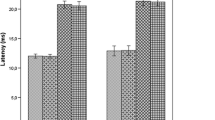Abstract
Pattern reversal visual evoked response (VER) and monaural stimulation of brainstem auditory evoked responses (BAER) were recorded from both sides in 25 patients (males 19; females 6) with hereditary spastic paraplegia (HSP). Their age ranged from 15–52 (mean±SD; 25.2±22.5) years and duration of symptoms 6 months-9 (mean±SD; 4.2±3.6) years. A prolonged P 100 latency was seen in 6 patients and BAER abnormality in 13. None of the patients had clinical evidence of brainstem involvement. It is suggested that VER and BAER abnormalities are due to segmental demyelination and fiber loss in central conduction pathways and could serve as an important tool for the diagnosis of this disorder.
Sommario
I potenziali evocati visivi (VER) e uditivi del tronco (BAER) sono stati registrati bilateralmente in 25 pazienti (19 maschi e 6 femmine) affetti da paraplegia spastica ereditaria (HSP). La loro età media era compresa tra 15 e 52 anni (media±DS=25.2±22.5) e con una durata di malattia compresa tra 6 mesi e 9 anni (media±DS=4.2±3.6). In 6 pazienti è stato riscontrato un aumento della latenza della P100 e in 13 i BAER erano anormali. Nessuno dei pazienti presentava segni clinici di coinvolgimento del tronco. Viene ipotizzato che le anormalità osservate ai VER e BAER sono dovute ad una demielinizzazione segmentaria o a perdita di fibre lungo le vie di conduzione cerebrale. Questi esami strumentali sarebbero quindi di grande utilità nella diagnosi di HSP.
Similar content being viewed by others
References
Bansal S.K., Sawhney I.M.S., Prabhakar S., et al.:Hereditary ataxias and spastic paraplegia. A clinical and electrophysiological study. Neurol. India, 36:151–162, 1988.
Carroll W.M., Kriss A., Baraitser M., et al.:Incidence and nature of visual pathway involvement in Freidreich's ataxia. Brain, 103:413, 1980.
Happel L.T., Rothchild H., Garcia C.:Visual evoked potentials in two forms of hereditary spastic paraplegia. Electroencephalogr. Clin. Neurophysiol., 48:233, 1980.
Harding A.E.:The hereditary ataxias and paraplegias. In: Swash M. and Oxbury J. eds. Clinical Neurology. Churchill Livingstone. Edinburgh (Vol. 2), pp. 1476–96, 1991.
Livingstone I.R., Mastaglia F.L., Edis R., Howe J.W.:Visual involvement in Freidreich's ataxia and hereditary spastic ataxia. Arch. Neurol., 38:75, 1981.
Nuwer M.R., Perlman S.L., Packwood J.W., Pieter K.R.A.:Evoked potentials abnormalities in the various inherited ataxias. Ann. Neurol., 13:20, 1983.
Pedersen L., Trojaborg W.:Visual, auditory and somatosensory pathways involvement in hereditary cerebellar ataxia, Friedreich's ataxia and familial spastic paraplegia. Electroencephalogr. Clin. Neurophysiol., 52:283, 1981.
Satya-Murti S., Cacae A.T., Hanson P.A.:Auditory dysfunction in Friedreich's ataxia — result of spiral ganglion degeneration. Neurology (NY), 30:1047, 1980.
Schwartz G.A., Liu C.N.:Hereditary (familial) spastic paraplegia. Arch. Neurol. Psychiat. (Chic), 75:144–62, 1956.
Werdelin L.:Hereditary ataxias, occurrence and clinical features. Acta Neurol. Scan., 73(106) Suppl.:14–26, 1986.
Author information
Authors and Affiliations
Rights and permissions
About this article
Cite this article
Sawhney, I.M.S., Bansal, S.K., Upadhyay, P.K. et al. Evoked potentials in hereditary spastic paraplegia. Ital J Neuro Sci 14, 425–428 (1993). https://doi.org/10.1007/BF02339171
Received:
Accepted:
Issue Date:
DOI: https://doi.org/10.1007/BF02339171




